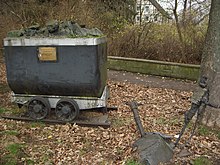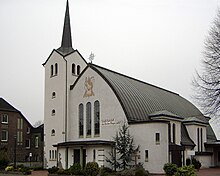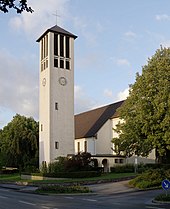Crowds
Massen is a town in the district town of Unna . It is located in the west of Unna, east of the city limits to Dortmund at the interface of the Westphalian regions Ruhr , Sauerland and Münsterland . The place name can be derived etymologically from the word water .
At the end of 2013, Massen had 10,616 inhabitants.
District structure
Mass is divided into four parts:
The settlement of Massen-Nord is located north of the actual main settlement core of Massens - divided into the Unna-Massen branch and the Buderus colony (also affectionately known as "Corsica" by the residents). The residential buildings of the former Massen colliery are located here.
Niedermassen , which is located on Hellweg, and Obermassen , which is located on Kleistraße, form the main settlement core of Massen. This area is characterized by bourgeois housing estates with single-family and terraced houses, as well as smaller multi-family houses. Obermassen is located in the approach path of Dortmund Airport and is affected by aircraft noise . The Karlstrasse noise monitoring system often has noise levels of over 80 dB (A) .
The southernmost and most rural part of Massen is the Massener Heide . This area is one of the preferred residential areas in Unna. Generous single-family houses and country houses dominate here.
geography
Massen has an area of 9.107 km². The lowest point in Massen is in Niedermassen on the Massener Bach at 63 m above sea level , the highest in the Massener Heide at 125 m above sea level and the town center at 70 m above sea level. In addition, there is a mountain in abundance called Stuckenberg , which is 118 m above sea level and in the Massener Heide. The total length of the Massener Bach, which runs from south to north, is 6.8 km.
history
In 1902, Niedermassen received approval for a “stop for passenger and milk transport” on the Westphalian Emschertal Railway with the station name “Massen”, but only after the municipality had committed itself to assuming the costs and assigning the necessary land.
The community of Massen was formed on April 1, 1911 through the merger of the previous communities of Niedermassen and Obermassen. In 1849 Niedermassen had 579 and Obermassen 458 inhabitants.
On December 1, 1910, the population was 3,167 for Niedermassen and 2,059 for Obermassen.
On January 1, 1968, Massen was incorporated into Unna.
After the transit camp for refugees and repatriates in 1951 of victories by the masses as Landesstelle Unna-Massen had been transferred (one of the largest reception centers in the Federal Territory), mass was given the high numbers of refugees from the German Democratic Republic for the first time the early 1960s and again late 1980s known beyond the national borders.
Population numbers
|
|
|
Infrastructure
Unna-Massen is connected to the inner cities of Dortmund and Unna by line 4 Dortmund – Lütgendortmund – Unna of the S-Bahn Rhein-Ruhr . The A1 is to the east of Massen . In addition, the B1 also runs through masses. There are two major main roads within the mass. The Hellweg forms an east-west connection and the clay road is a north-south connection. The Verkehrsgesellschaft Kreis Unna (VKU) also operates bus routes through Massen. There is also a park-and-ride system.
schools
There are currently three schools en masse : two primary schools ( Sonnenschule in Obermassen and Schillerschule in Niedermassen) and the Hellweg Realschule .
The Gerhart-Hauptmann-School for refugees and migrants in Massen-Nord was closed. Since May 31, 2011 there has been a private university on the area of the former Gerhart-Hauptmann-Schule with 17 courses in management, sport and health.
Culture / sport
Playgrounds, offers for young people, fire brigade
There are playgrounds for children, the youth center of the Protestant parish, a football field on Virchowstrasse and youth departments of the sports clubs and the volunteer fire brigade .
Sports clubs and facilities
The following sports clubs are in abundance: SG Massen foot and handball, SGH Unna Massen (handball), FSG Massen, EVC Massen volleyball and 1.TC Massen tennis. There is also a DLRG local group. Choirs en masse: MGV Glückauf Massen 1880, MGV Cantus 1880 and Chor 72. The HSM association has been running the Massener indoor swimming pool on Königsborner Strasse for over ten years; Free swimming times are offered there on Sundays.
Between 1982 and 2012, the Unna-Massen brine and leisure pool was located on Kleistraße . However, operations ceased in 2009/2010 and the complex was demolished in 2012.
There is an equestrian center in the Massener Heide.
Events
Every Saturday from 7.30 a.m. to 1.30 p.m., a weekly market opens on the parish square. Every year in Advent, a three-day Christmas market takes place in front of the former municipal administration, organized by the trade association Massen. Every two to three years, a fair , the Massener Hellweg Rummel , is organized on the Massener Hellweg . On the first weekend in January, women's soccer teams from all over Germany compete in Unna. The women's and girls' area of the SG Massen organizes one of the largest national artificial turf tournaments, the "Ladies Cup".
Mining

Mining began en masse in 1827, when Gisbert Freiherr von Romberg , owner of the Massen house, applied for the excavation of the Romberger Erbstollen at the mining area . This tunnel was supposed to drain the mines in the Holzwickede - Aplerbeck - Sölde area . In 1829 work began on driving the Romberger Erbstollen, which was 1.40 m wide and 2.30 m high. The tunnel mouth hole was located on the Massener Bach, near today's Im Kamp road. At times, up to 80 miners were busy driving the tunnel from the Massener Bach through the marl blanket to the southwest in the direction of Holzwickede. The work proceeded rapidly at first, until 1833 the breakthrough with three deepened light holes was made. In the course of time, however, fissured marl and high water inflows made it difficult to drive the Romberger Erbstollen further, so that the fourth light hole in the area "Zur Alten Colonie" in Holzwickede could not be reached until 1837. After the tunnel reached a length of 2365 meters in 1838, the drive was finally stopped in the same year due to renewed strong water inflows and water withdrawal complaints by landowners. The Romberger Erbstollen had not yet reached the coal mountains. In the 1850s and 1860s, the United Norm colliery , which had sunk a shaft on the 3rd light hole, used this tunnel to dissolve water.
The idea of coal mining en masse was not taken up again until 1853. A Massener Coal Mining Society was established. In 1855, the sinking of shafts 1 and 2 of the Massener Tiefbau colliery began . The first coal was mined in shafts 1 and 2 of the Massen mine in 1859. The workforce at that time consisted of 92 miners. A railway connection was created between the pits and the Holzwickede-Unna line.
In 1860, 3686 tons of coal could be mined. In the following years a large number of jobs arose at the colliery, so that more and more miners immigrated in bulk. Therefore, some mining settlements were built, for example the colonies Im Kamp and An der Ladebühne . From 1882 a coking plant and a briquette factory were operated at the Massen mine .
In 1883 there was a firedamp explosion with 15 dead and three injured. The Massener miners take part in the miners' strike of 1889. A year later, a fire completely destroyed the shaft building of the production shaft. In 1895, the sinking for shaft III began; this work cost 4,136,112 marks . Two years later, coal mining could begin. At that time, the total workforce in shafts 1, 2 and 3 was 1,772 men. At the turn of the century, 2301 miners were working at the Massen mine. A year later, the sinking of shaft 4 was completed and the shaft was put into operation.
In 1910 the mining corporation "Massen" was taken over by AG Buderus ' sche Eisenwerke and on January 1, 1911 it was fully integrated into the new parent company. The highest annual output was achieved by 2,807 employees in 1913 with 659,762 tons. When the first prisoners of war (100 Russians) arrived en masse in 1915, they were assigned to the mine as workers. In the middle of the First World War (1916) a miners' colony ( Buderus colony ) was built. In 1918, after the emperor's abdication, a workers' council reduced working hours to eight hours and a wage increase from 15 to 17 marks. For economic reasons, the Massener Tiefbau colliery was closed by AG Buderus'sche Eisenwerke in 1925 . From then on, the Alter Hellweg colliery took over the mining of the remaining coal deposits . Thus 3,621 miners were immediately unemployed. At the time of the closure, the output was 500,000 tons per year.
Personalities
- August Rosterg (1870–1945), General Director of Wintershall AG and member of the " Friends of the Reichsführer SS "
Web links
- Our masses
- SG Massen 1911/45 eV
- Women's Cup - the largest women's football tournament in Germany
- Crowds in the Westphalia culture atlas
Individual evidence
- ↑ Stephanie Reekers: The regional development of the districts and communities of Westphalia 1817-1967 . Aschendorff, Münster Westfalen 1977, ISBN 3-402-05875-8 , p. 261 .
- ^ MF Essellen: Description and brief history of the Hamm district and the individual localities in the same . Verlag Reimann GmbH & Co, Hamm 1985, ISBN 3-923846-07-X , p. 168 f .
- ↑ www.gemeindeververzeichnis.de: Population figures 1910
- ↑ Martin Bünermann: The communities of the first reorganization program in North Rhine-Westphalia . Deutscher Gemeindeverlag, Cologne 1970, p. 65 .
- ↑ homepage IUNunna. Retrieved March 21, 2012 .
Coordinates: 51 ° 32 ' N , 7 ° 39' E







